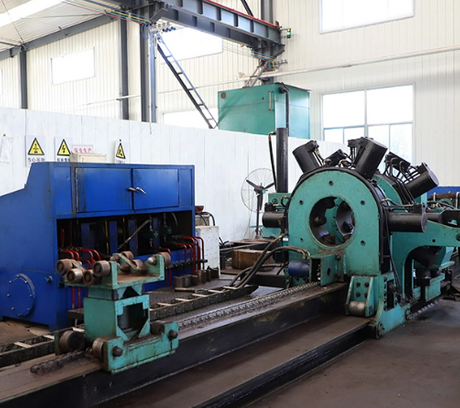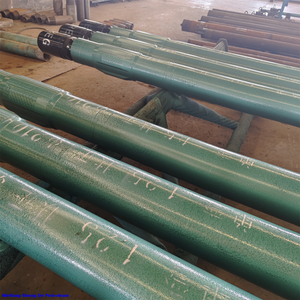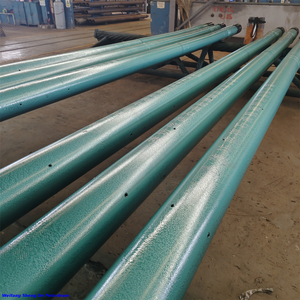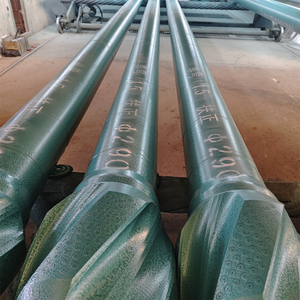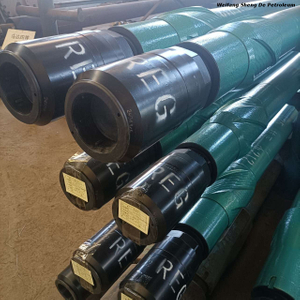You should know the main difference between active and passive drilling jars. Active jars let you control the impact more. Passive jars react to forces in the well. Picking the right jar can help you drill better and faster. It can also make your work more reliable. Here is a comparison:
Type of Jar | Impact Control | Suitability | Reliability |
Active | Controlled impact | Specific operational needs | Higher reliability in sensitive environments |
Passive | Responds to forces | Varied conditions | May be less reliable in sensitive environments |
New designs in drilling jars use better energy storage. They also use stronger materials. These changes help you drill quicker and stop less often. Shengde is a trusted brand. They make strong drilling jars for tough oilfield jobs.
Key Takeaways
Active drilling jars let you control how hard they hit. This makes them good for hard jobs in deep wells.
Passive drilling jars work by themselves when they feel resistance. They give fast help for normal drilling work.
Picking the right jar for the well can save time. It can also help drilling go better.
Taking care of drilling jars, like cleaning and oiling them, helps them last longer. It also makes them work better.
Shengde has strong drilling jars and expert help. They can help you pick the best tool for your job.
What Are Drilling Jars?
Drilling Jar Function
You use a drilling jar when you need to solve problems downhole. This tool acts like a hammer inside the well. When your drill string gets stuck, the drilling jar delivers a strong impact to free it. People also call it a hammer drilling jar because it gives a sharp hit to un-jam tools or equipment. The drilling jar stores energy and then releases it quickly. This action creates a shock wave that travels through the drill string. You can use this tool in drilling, completions, and well workover jobs.
Here are some main functions of drilling jars:
Freeing stuck pipes by giving a sudden impact.
Breaking or loosening hard obstructions in the well.
Helping to transmit torque during drilling.
Cleaning the wellbore by dislodging debris or scale.
You can find different drilling jar types, such as mechanical, hydraulic, and mechanical-hydraulic models. Each type works best in certain situations.
Importance in Oilfield Operations
You need reliable tools to keep your drilling operations running smoothly. The drilling jar plays a key role in this process. When you face stuck pipes or tough formations, the drilling jar helps you avoid long delays. It restores movement to your tools and prevents bigger problems. This tool can reduce stuck pipe incidents by up to 30%. That means you spend less time fixing issues and more time drilling.
Many companies, like Exxon Mobil and Halliburton, use advanced drilling jar models to improve efficiency. These tools help lower downtime and cut costs. Shengde offers high-quality drilling jars that stand up to harsh conditions. Their products help you finish jobs faster and safer. When you choose the right drilling jar, you protect your project and your budget.
Active Drilling Jars Explained
Active Mechanism Overview
You use an active drilling jar when you want to control the impact force. The mechanical jar holds energy in the drill string. You can pull or loosen the drill string to store energy. When you reach the needed force, the jar lets this energy go fast. The inside and outside parts move to make a strong hit. This works the same in hot or cold wells, so it is always reliable.
The mechanical jar holds energy with friction.
It has a lock that uses ribbon slips.
You can set the jar at the surface or down in the well.
The jar only works after you use enough weight or torque.
This design lets you control the tool. You choose when and how hard it hits.
Pros & Cons
You should know the good and bad things about active jars. The table below shows how mechanical jars and hydraulic jars compare. Both are types of active drilling jars.
Advantage/Disadvantage | Mechanical Jars | Hydraulic Jars |
Activation | Only works after set force is reached | Can work by accident if it gets too hot |
Durability | Stronger and lasts longer | Not as strong because it can get too hot |
Noise Resistance | Handles noise better | Handles noise less well |
Operational Life | Lasts longer | Does not last as long if it gets too hot |
Overheating Issues | Not likely to overheat | Can overheat if used too much |
A mechanical jar lasts longer. It will not work until you reach the set force, so you do not get surprise hits. A hydraulic jar can work by accident if it gets too hot, which makes it less useful. The double-acting hydraulic mechanical drilling jar mixes both types for more options.
Typical Applications
You can use active drilling jars in many drilling jobs. These jars work in straight and slanted wells. You pick a mechanical jar for hard jobs, like deep or hot wells. The jar helps you free stuck pipes and tools fast. You also use hydraulic jars and fishing jars for these jobs, but the mechanical jar gives you more control.
Drilling Scenario | Conditions Affecting Use |
Vertical Wells | Depth, heat, and chance of stuck pipe |
Deviated Wells | Depth, heat, and chance of stuck pipe |
You can trust an active drilling jar for tough drilling work. It helps you finish your job and saves time.
Passive Drilling Jars Explained
Passive Mechanism Overview
A passive drilling jar reacts to forces in the well. You cannot control the impact by yourself. The jar works when the drill string gets stuck or meets resistance. It stores energy as you pull or push on the drill string. When the force gets high enough, the jar releases the energy. This makes a strong jarring impact. You do not have to set the tool before using it. The jar works by itself when needed.
Tip: Passive jars are good for simple jobs. They work best if you think the pipe might get stuck or meet sudden resistance.
Pros & Cons
It is important to know how passive jars and active jars are different. The table below shows the main differences:
Feature | Passive Drilling Jar | Active Drilling Jar |
Impact Control | Automatic | Manual |
Ease of Use | Simple | Requires setup |
Response Speed | Fast | Depends on operator |
Versatility | Good for varied conditions | Best for specific jobs |
Passive jars are easy to use. You do not have to change settings or watch the tool all the time. The jar acts fast when the pipe gets stuck. You do not get as much control over the impact, but you get speed and easy use.
Typical Applications
You can use passive drilling jars for many oilfield jobs. These jars are good for wells where things might get stuck or change quickly. They work in vertical, slanted, or shallow wells. Many workers pick passive jars for normal drilling, fishing, and workover jobs.
Freeing stuck drill strings in shallow wells
Handling unexpected obstructions
Supporting routine drilling operations
Passive jars are good for jobs that need a quick response and simple use. You do not need special training to use them. The jar helps you keep drilling with less waiting.
Active vs. Passive: Key Differences
Operational Control
You need to understand how much control you have during drilling jar operations. Active jars give you the power to decide when and how hard the impact happens. You set the force at the surface or downhole. When you reach the right tension, you release the energy. This means you can plan each jarring action. You can adjust your approach if the well conditions change.
Passive jars work differently. You do not control the exact moment of impact. The jar reacts to the forces in the well. When the drill string gets stuck or meets resistance, the jar releases its energy automatically. You do not need to set anything before using it. This makes passive jars simple to use, but you lose some control over the timing and strength of the impact.
Tip: If you want more control during drilling jar operations, choose an active jar. If you want a tool that works on its own, a passive jar is a good choice.
Performance and Versatility
Performance and versatility matter a lot in drilling jar operations. Active jars perform well in tough jobs. You can use them in deep wells, high-pressure zones, or when you need a strong impact. You can also use them in wells with changing conditions. The ability to control the jar helps you handle many types of drilling challenges.
Passive jars offer good performance in routine jobs. You can use them in shallow wells or when you expect sudden resistance. They work best when you need a quick response. You do not need special training to use them. This makes passive jars versatile for many teams and projects.
Here is a table to help you compare:
Feature | Active Jars | Passive Jars |
Control | High | Low |
Response Time | Operator decides | Automatic |
Training Needed | More | Less |
Best for | Complex wells, deep drilling | Routine jobs, shallow wells |
Application Scenarios
You will find that each type of jar fits different drilling jar operations. Active jars work best in wells where you expect tough conditions. You might use them in deep wells, high-temperature zones, or when you need to free stuck tools with precision. You can also use them in directional drilling, where control is very important.
Passive jars fit jobs where you want a simple and fast solution. You can use them in vertical wells, workover jobs, or when you expect the drill string to get stuck without warning. Many teams use passive jars for fishing operations or routine drilling tasks.
Choosing the right jar helps you finish drilling jar operations faster and with fewer problems. You protect your equipment and keep your project on track.
Choosing the Right Drilling Jar
Factors to Consider
You must pick the right jar for your drilling job. The jar you choose depends on your drilling needs. Think about how deep your well is. Look at the type of rock underground. Check if stuck pipe happens often. Each jar works best in certain jobs.
Here are some things to think about:
Deep wells need jars that handle high pressure and hard rocks. Stuck pipe can happen when mud pressure is higher than rock pressure.
Shallow wells or simple jobs use jars that work fast and need little setup.
If stuck pipe is common, pick a jar that frees the pipe quickly.
Problems with machines or rocks can cause stuck pipe. Choose a jar that fits these problems.
You can see the main jar types and their key points in this table:
Type of Jar | Description | Key Considerations |
Drilling Jar | Jars and releases jams during drilling or tripping | Needed for steady drilling work |
Fishing Jar | Unsticks tools from the well; not for long-term drilling | Only for jobs where tools get stuck |
Surface Jar | Used at the wellhead; provides downward jarring effect | Easier for surface work |
Mechanical Jar | Operates on mechanical friction; adjustable force | Needs strong parts and careful making |
Hydraulic Jar | Uses hydraulic oil for jarring; upward jolts only | Can wear out and change with heat |
Double-Acting Hydraulic Mechanical Jar | Combines mechanical and hydraulic advantages | More reliable and works better |
Tip: Pick a jar that matches your drilling job. This helps you work faster and avoid problems.
Shengde Product Support
You want a jar that works well and lasts a long time. Shengde gives you strong jars and good help. The company makes jars for hard oilfield jobs. Their experts know about drilling problems. If you have questions, you can ask their team for help.
Shengde cares about quality and helping customers. Their jars meet high standards. The jars work in deep wells, tough places, and easy jobs. You can trust their jars to keep your work going.
You get expert advice for picking the right jar.
You get help before and after you buy.
You use jars that work in tough places.
Note: Good help lets you fix problems faster and keeps your drilling safe.
Conclusion
Now you know that active and passive jars are not the same. Active jars let you control the force and are good for hard jobs. Passive jars act fast and are best for normal work. Picking the right drilling jar keeps your work safe and quick. If you need strong tools or help, Shengde can help with your next job.
FAQ
What is the main difference between active and passive drilling jars?
You control the impact with active drilling jars. Passive drilling jars react automatically to forces in the well. Active jars give you more control. Passive jars offer quick, simple use.
When should you use an active drilling jar?
You should use an active drilling jar for deep wells, tough formations, or when you need precise control. This type works best when you want to decide the timing and strength of each impact.
How do you maintain a drilling jar?
You should clean the jar after each use. Check for wear or damage. Lubricate moving parts. Store the jar in a dry place. Regular maintenance helps your jar last longer and work better.
Who can help you choose the right drilling jar?
You can contact Shengde's expert team. They help you match the right jar to your drilling needs. You get advice before and after your purchase.










